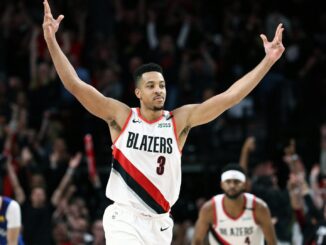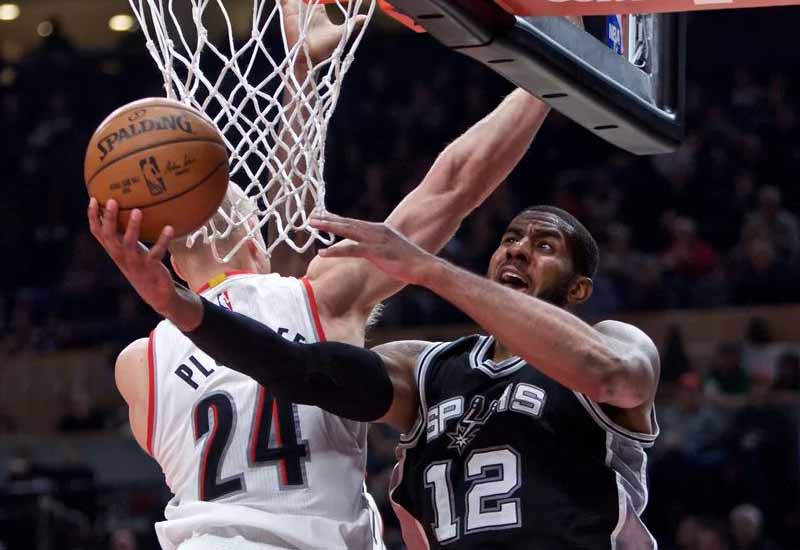
The Portland Trail Blazers’ 2016-17 season was a year defined by high ambitions and unmet expectations. The team saw a regression to the mean after shocking the league just a year prior, but there is plenty of talent on the roster that can help the team improve.
Ahead of 2017-18, Oregon Sports News’ Jared Wright and Bryant Knox will be breaking down the strengths, weaknesses and recent showings from each and every Trail Blazers player. Today, we take a look at one of the more intriguing of the otherwise mediocre options at the forward spots, the young Moe Harkless.
2016-17 Recap
| GP | MPG | PPG | RPG | APG | FG% | 3PT% | FT% | TPG | SPG |
| 77 | 28.9 | 10 | 4.4 | 1.1 | 50% | 35% | 62% | 1.1 | 1.1 |
Harkless’ stats initially don’t overwhelm by any reasonable stretch; in fact, I can barely even get whelmed by them. Playing nearly 29 minutes a game, with a 68/32 split between spending time at the 3 and the 4 positions (what are traditionally called the small forward and power forward), Moe seemed to be merely the default option, due to Ed Davis dealing with injury, Meyers Leonard dealing with inconsistency, Evan Turner dealing with both, and Al-Farouq Aminu seeing his outside shooting fall off a cliff.
Dig deeper, and you’ll see that Harkless certainly took advantage of increased opportunities. Playing 2,223 total minutes (a career high), he set new highs in starts, Field Goals Made and Attempted, Three-Pointers Made and Attempted, Points and Points Per Game (averaging double digits for the first time in his career), Blocks, True Shooting Percentage, Win Shares and Value Over Replacement Player.
Is the increased production just due to getting 29 minutes per game over 77 games, though? It mostly is. And for a wing-sized guy who played a good chunk of those minutes at the 4, I was disappointed to discover that he made only 68 threes last season, and shot below the league average percentage-wise.
However, there is good news. Hark significantly improved his shooting from all areas of the floor except right at the rim. His percentage at the rim fell from 66% to 61%, but that was expected; it would be nuts to expect Harkless at a skinny six-foot-nine to continue finishing two-thirds of his layups, due to sheer variance. Everywhere else on the floor distance-wise, Moe improved his shooting by at least four percentage points in each area, huge improvements that are not reflected in his pedestrian traditional shooting splits.
Moe also had a Usage Rate of only 15.2%, well behind Turner. He often deferred to Turner and Allen Crabbe, as well as CJ McCollum, when running with the second unit. With Crabbe gone to Brooklyn, it seems likely that McCollum, Damian Lillard, and Turner gobble up the possessions used by Crabbe. In a perfect world, Harkless would also get more chances, as long as he’s assertive.
What He Brings to The Table
Harkless brings length, athleticism, and the ability to finish to the 3 spot, and speed, some range (his below-average three-point shooting aside), and defensive switch ability to the 4 spot. Since the frontcourt is so crowded these days, the expectation is that Moe will mostly play on the wing as a small forward, especially if Shabazz Napier can’t crack the rotation (forcing McCollum to be the backup point) or Jake Layman’s Hair doesn’t get a chance to play.
Something I need to mention is Harkless’ penchant for what I like to call “MoreyBall Shots,” which are corner three-pointers and shots at the rim. The majority of Moe’s shot attempts are either from the paint or the corners, which is good; a guy at Hark’s level on the Blazers’ totem pole needs to be as efficient as possible with the shots he does get. He has shot about 62% from the restricted area during his Portland career, a stellar number for a non-big.
His corner three percentage, though, is a putrid 30%. That’s especially alarming because Portland coach Terry Stotts likes to put his forwards in the corners while Lillard runs the offense, and with the attention Lillard does attract when he drives, the guy standing in the corner will get a decent try as he shoots the most efficient shot in basketball. If said guy stinks at the shot, however, things get rough for the guard penetrating into the paint. Harkless’ man can dive into the lane, help deny easy points for Lillard or McCollum, and not have to worry about giving up three points.
Harkless, both by his play and by his personality, seems like a guy who is just there; I didn’t refer to him as cauliflower in the Evan Turner preview just for a cutesy reference. There’s nothing really wrong with that, per se, but I would like to see him get pushed a little more by the coaches to expand his game some. Harkless will never be a good distributor or have the best vision when it comes to reading defenses, but he has the ability to be more of a slasher and cutter. It depends on whether Stotts will bend his offense to allow Harkless to get to the rim more, where he’s been good for the Blazers.
What to Expect in 2017-18
Unlike his main competition for the starting 3 spot, Harkless is young enough to still have another level to get to. He’s not star material by any stretch of the imagination, but he does have a little more left before he reaches his ceiling. Whether that’s by improving his three-pointer, upping his game on defense, scrapping harder on the boards, or learning the subtle art of the screen (imagine the jumpy Harkless rolling to the rim after setting a screen for Lillard…), there are still avenues for the 24-year-old to explore before he reaches the “he is what he is” stage of his career.
First, though, he has to beat out Turner for the starting job. And since Turner makes as much money as Harkless and Aminu combined (Hark is on the second year of a four-year, $40 million contract), I imagine that there is subtle pressure on the coaches to give Turner a longer look than he might deserve.
Whether he starts or not, I expect Harkless to play big minutes. Here’s hoping he continues to improve, and that improvement translates into wins, and a lightened load on the Blazers’ dynamic backcourt.
Check out the rest of our series down below




